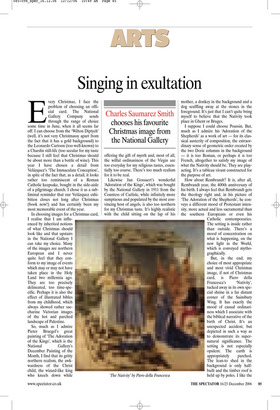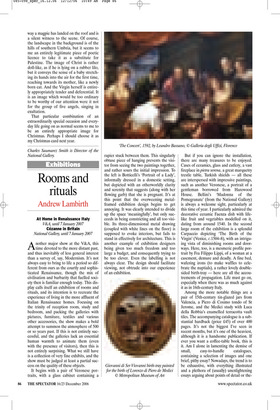Singing in exultation
Every Christmas, I face the problem of choosing an official card. The National Gallery Company sends through the range of choice some time in June, when it all seems far off. I can choose from the ‘Wilton Diptych’ (well, it’s not very Christmassy apart from the fact that it has a gold background) to the Leonardo Cartoon (too well-known) to a Chardin still-life (too secular for my taste because I still feel that Christmas should be about more than a bottle of wine). This year I have chosen a detail from Velázquez’s ‘The Immaculate Conception’, in spite of the fact that, as a detail, it looks rather too reminiscent of a Roman Catholic keepsake, bought in the side-aisle of a pilgrimage church. I chose it as a subliminal reminder that our Velázquez exhibition closes not long after Christmas (book now!) and has certainly been my most memorable event of the year.
In choosing images for a Christmas card, I realise that I am influenced by inherited notions of what Christmas should look like and that upstairs in the National Gallery I can take my choice. Many of the images are northern European and I never quite feel that they conform to my image of events which may or may not have taken place in the Holy Land two millennia ago. They are too precisely delineated, too time-specific. Perhaps it is also the effect of illustrated bibles from my childhood, which always showed rather saccharine Victorian images of the hot and parched landscape of Palestine.
So, much as I admire Pieter Bruegel’s great painting of ‘The Adoration of the Kings’, which is the National Gallery’s December Painting of the Month, I find that its gritty northern realism, the awkwardness of the Christ child, the wizard-like king who kneels down while offering the gift of myrrh and, most of all, the wilful ordinariness of the Virgin are too everyday for my religious tastes, essentially too coarse. There’s too much realism for it to be real.
Likewise Jan Gossaert’s wonderful ‘Adoration of the Kings’, which was bought by the National Gallery in 1911 from the Countess of Carlisle, while infinitely more sumptuous and populated by the most convincing host of angels, is also too northern for my Christmas taste. It’s highly realistic with the child sitting on the lap of his mother, a donkey in the background and a dog scuffling away at the stones in the foreground. It’s just that I can’t quite bring myself to believe that the Nativity took place in Ghent or Bruges.
I suppose I could choose Poussin. But, much as I admire his ‘Adoration of the Shepherds’ as a work of art — for its classical austerity of composition, the extraordinary sense of geometric order created by the two Doric columns in the background — it is too Roman, or perhaps it is too French, altogether to satisfy my image of what the Nativity should be. They are playacting. It’s a tableau vivant constructed for the purpose of art.
How about Rembrandt? It is, after all, Rembrandt year, the 400th anniversary of his birth. I always feel that Rembrandt gets the theology right and, in his picture of ‘The Adoration of the Shepherds’, he conveys a different mood of Protestant intensity, more actual and less sacramental than the southern Europeans or even his Catholic contemporaries. The setting is inside rather than outside. There’s a mood of concentration on what is happening, on the new light in the World, which is conveyed mythographically.
But, in the end, my choice of most appropriate and most vivid Christmas image, if not of Christmas card, is Piero della Francesca’s ‘Nativity’, tucked away in its own special shrine in a far distant corner of the Sainsbury Wing. It has exactly the mood of casual ordinariness which I associate with the biblical narrative of the birth of Christ. It’s an unexpected accident, but depicted in such a way as to demonstrate its supernatural significance. The setting is not especially opulent. The earth is appropriately parched. The lean-to shed in the background is only halfbuilt and the timber roof is held up by poles. I like the way a magpie has landed on the roof and is a silent witness to the scene. Of course, the landscape in the background is of the hills of southern Umbria, but it seems to me an entirely legitimate piece of poetic licence to take it as a substitute for Palestine. The image of Christ is rather doll-like, as if he is lying on a rubber lilo, but it conveys the sense of a baby stretching its hands into the air for the first time, reaching towards its mother, like a newly born cat. And the Virgin herself is entirely appropriately tender and deferential. It is an image which would be too ordinary to be worthy of our attention were it not for the group of five angels, singing in exultation.
That particular combination of an extraordinarily special occasion and everyday life going on as normal seems to me to be an entirely appropriate image for Christmas. Perhaps I should choose it as my Christmas card next year.







































































































































 Previous page
Previous page